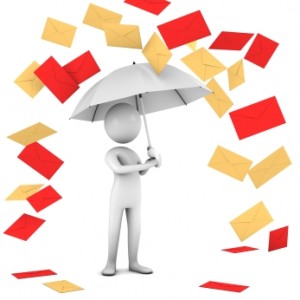It's Raining Email

Email Inbox – 1,846,752 You - 0
Feel defeated by the amount of emails in your inbox? Managing your e-mail inbox can be a chore, especially if you receive hundreds of messages a day. As messages build up, the task of reading and addressing each one may seem impossible, and for most becomes a daunting task. For some, the go-to answer is to ignore some correspondences because most of them are spam or junk and don't require a response. This isn’t the best solution as one can miss deadlines or get on someone’s bad side if something urgent isn’t addressed in a timely manner.
Don't let yourself be overwhelmed. There is an effective way to process and organize your inbox and just remember it’s never going to be perfect. Keeping a clean inbox can help limit stress and anxiety. You just need to find some ways that work best for you.
It’s taken me a long time to figure out how to manage my inboxes over the years, but I am more organized than ever after some trial and error. The tips below can help you make your email more manageable moving forward.
Create a Filing System
There’s no single structure of folders or mailboxes that works for everyone so you need to design one that works for you and your role. When creating a folder structure, think about what you’re most likely to remember when you want to find a message in the future. Some people organize their inboxes by sender name, where you should build your hierarchy based on people. If it’s the project, then a set of project folders makes sense. Since I am a project manager at Function1, I create folders for each project I am managing and everything pertaining to that project will be filed into that folder. This includes all my sent messages as well. Everything from budgets, timelines, risks, issues, invoicing, meeting notes, etc. will go into that folder. Once a project is completed, the folder is archived.
Create Categories/Flagging System
Most email clients allow you to create categories with a coloring system for emails. I use this on a daily basis and it really helps me prioritize my emails. It also helps me create a task list for the day. I can address the ones I consider urgent first and the others can sit tight until I have some time to respond. An example of how one can use the category/flagging system in their email is outlined below:
· Red – Urgent (must be replied to same business day it was received)
· Yellow – Waiting for a response from someone.
· Blue – Personal (Ex: Need to ensure annual health enrollment is completed by x date)
· Green – A reply is necessary, however it can wait 1-2 business days (isn’t urgent).
Block Time on Calendar to Check Emails
I’ve worked with many individuals who would block time on their calendars twice a day for about 20-30 minutes so they can go through their emails. This is an efficient way to ensure you are checking emails, but not living in your inbox all day long.
Archive Emails Daily
I know this may seem like an impossible thing to do, but it really helps. If you get in the habit of checking email a few times a day, flagging it appropriately and moving them to the correct folders, your inbox won’t seem so overwhelming. Archiving daily will also save time in the long run since most tend to just have emails pile up in the inbox for months. Archiving every few months is a chore and extremely time consuming. It’s definitely a sense of accomplishment at the end of each day to know that your inbox doesn’t have items in it that are irrelevant.
Hit Delete
Many people are scared to delete emails, but keeping every single one is unnecessary. Daily/Weekly/Monthly newsletters, meeting notices, time and expense reminders, etc. can be deleted. It’s one less message to file, flag and stress about. Another idea is to delete items that you’ve kept for a certain amount of time (30 days, 60 days, 90 days, etc.) that you’ve done nothing with. This may not work for everyone, but it’s easier to have this rule to help clean up your inbox.
Use Automatic Out of Office Replies
Lastly, if you are in meetings all day or travelling, I suggest setting up that out of office reply, which will let the sender know there will be a delay in your response. This will relieve pressure on you to respond right away.
- Log in to post comments

